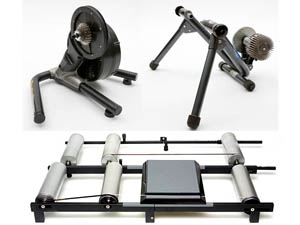
The wonderful feeling of steady speed cruising on the flats is subject to two factors: resistance and inertia. Resistance consists of two components: rolling and aerodynamic resistance. Rolling resistance is constant, while aero is progressive and ramps up as a function of the square of speed. The faster you go, the greater the role aero resistance plays. Inertia is simply the effect of your mass going down the road plus, to a much lesser extent, the rotational inertia of your spinning wheels.
Indoor training tools often tout their realistic road feel, for good reason. You want to train under the same conditions you race on. As it turns out, they have two components in their resistance as well, drivetrain and air, fluid, or magnetic resistance, and they correspond quite well to rolling and aero resistance. Inertia is usually replicated with flywheels. Here’s a look at how two trainers and two rollers stack up in terms of resistance and inertia.
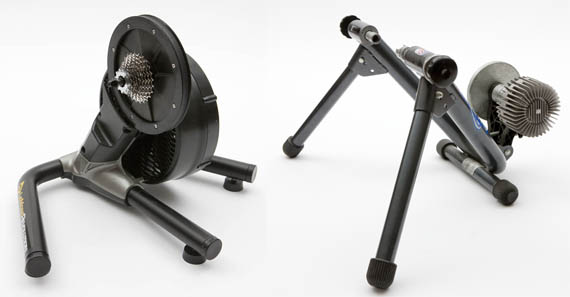

Resistance
Here’s a mathematically generated resistance graph for a typical road rider with a CdA of .37 and Crr of .005. Resistance (Newtons) is plotted against speed (meters/second) squared. The y-intercept is the constant force of rolling resistance, while the up-sloped line represents the progressive force of aero resistance. You could divide the area under the line into the two separate components.
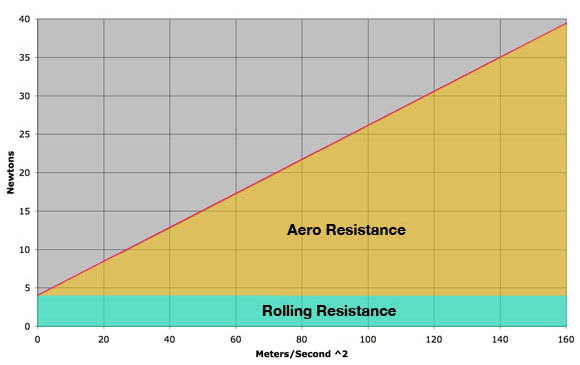
Here’s the LeMond Revolution compared to that road rider. This plot was created by riding for one minute intervals at a steady speed for a range of speeds. Note how the two slopes are very similar, indicating that aero resistance ramps up very similarly for the two. Since the LeMond’s drivetrain consists of a chain and a belt drive, both very efficient power transmitters, it has less rolling/drivetrain resistance than a road rider, who relies on tires on the road to deliver power.
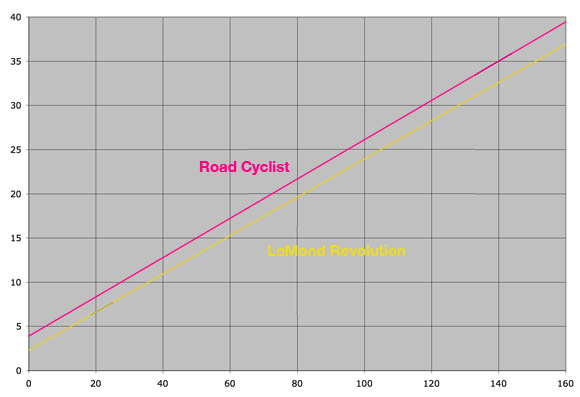
Here’s the Kinetic added to that graph, using Kinetic’s own published data. While the road rider has 4 N of rolling resistance and the LeMond 2.5 N of drivetrain resistance, the Kinetic has a whopping 12 N of drivetrain resistance. A small drum biting into a tire is clearly a very inefficient way to transmit power. Even though its fluid resistance unit ramps up at the same rate as our road rider, the huge amount of drivetrain drag changes the total resistance dramatically. The net effect is more resistance at all speeds and a less realistic ramp up.
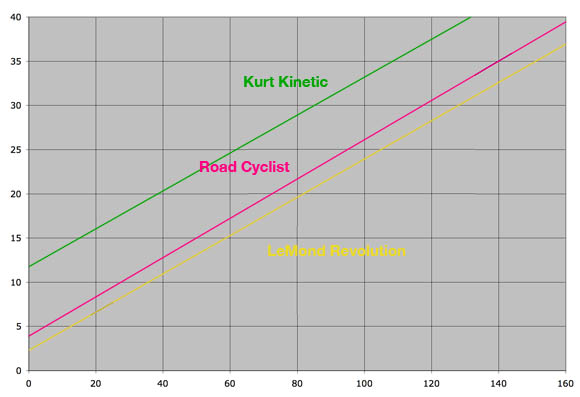
Here’s the same graph with TruTrainer and Kreitler rollers added to the mix. Most of the resistance from rollers come from the tires on the drum, and since the drums bite into the tires more than a flat road surface, rolling resistance is higher than our road rider. The TruTrainer adds a bit of resistance with an internal flywheel, so its plot is a bit higher than the Kreitler’s. Both have a very shallow upslope, probably from the air resistance of the spinning wheels. I used the same wheels for both tests, so that explains the same slope for both lines. As you can see, resistance doesn’t ramp up much, which is why you can easily ride at 40 mph on rollers.
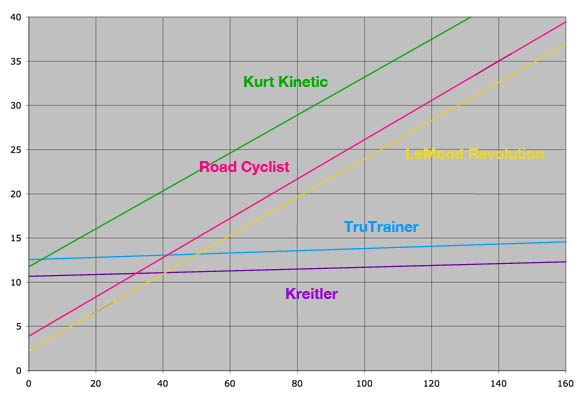
Inertia
Inertia is much easier to test for. I simply measured the coastdown time for each from 20 mph. With its low drivetrain drag and big flywheel, the LeMond won easily with 65 seconds. TruTrainer, with its beautifully milled drums and internal flywheel, came in second at 38 seconds. The Kinetic has a pretty heavy flywheel, but with its inefficient drivetrain it only coasted for 14 seconds. Kreitlers, with almost as much rolling resistance as the Kinetic but no flywheel, came in last at 6 seconds.
So why does inertia matter? Who cares how long coastdown takes? Keep in mind that your pedal output isn’t constant – you have a power peak with each downstroke. If you have a lot of inertia, you’ll maintain more of your speed between power peaks, it’s that “staying on top of the gear” feeling. With less inertia, you’ll have to re-accelerate with each downstroke to maintain the same average speed, and you’ll work harder through the dead spots.
Put it all together…
The LeMond Revolution feels fantastic, and it’s interesting that the numbers bear out the sensation. You can crank out tons of power without abusing your knees. The free spinning slippery sensation adds to the fun factor. It’s really easy at endurance pace, really hard at threshold, just like road riding.
I’ve always found the Kurt Kinetic brutal to ride. Its extra drag and minimal coastdown hurt the backs of my knees. I always wanted to overcome this, thinking I’d be a better climber if I could just fight my way through it. But in the end the misery and the fear of damaging my knees always cut my workouts short.
Rollers are much more pleasant to ride. Even though they have much more rolling resistance than the road, they spin quite nicely since they don’t have much wind resistance. The drawback, of course, is the difficulty of putting out big watts on rollers. You can always resort to tricks like running less air in your tires, putting a towel under the drums, or getting a resistance attachment.

Does appear that wind trainers have the most similar curve to road riding based on this data as well. I used to have an old racer mate – turns out those were pretty good…
http://brown-snout.com/cycling/tech/trainer_power_comparison/
This is a fact, read it here:
http://www.kurtkinetic.com/powercurve.php
It says that Kurt Kinetic stimulates the wattage of a 165 pound cyclist on a standard bike on a rough pavement on a 1% gradient.
(Thus, the greater wattage is from this formula, not unit resistance. You probably had the tension too tight.)
You can calculate the speed of riding on an indoor velodrome with a slick aero bike by adding almost 10 kph. See http://www.analyticcycling.com
The KK has a great feel with much less slippage than many spring lever units.
I couldn’t have had the tension too tight, I used their data. I didn’t generate the Kinetic numbers in that graph, I graphed the numbers from Kinetic’s pdf you link.
If you just ride the two trainers the difference in feel is pretty obvious.
Flying Garmendez must have something else on his mind:
“It says that Kurt Kinetic stimulates….
….tension too tight…..
…great feel with much less slippage…..”
I emailed with Ross Belloni of TruTrainer, here’s the deal. I just did 26 minutes at 180w @ 27.7 mph. TruTrainer’s data, based on the average of 10 units, is 313w @ 28 mph. There are some potential culprits for the difference.
1. Loose flywheel drive belt – I tightened mine just before riding today.
2. Tire choice/pressure – they ran clinchers @ 100 psi, I ran tubeless @ 100 psi. Maybe rolling resistance is much lower with tubeless? If so that would be great.
3. Grease breakdown in the bearings – They spec a heavy grease to add to the resistance, maybe the grease in my bearings have broken down over time.
So that’s where we stand. FYI, Ross’ own rollers, with 5000 miles on them, at the same speed, feels like 200 w to him (he doesn’t use a power meter).
Great pair of articles, Andy. Do you have a guess as to how rollers with a fan unit would compare with this product in terms of duplicating road feel. Seems as if the fan would take it away from being all rolling resistance.
To answer the last 2 questions. Rollers alone have minimal inertia, adding a resistance unit would give you a high resistance low inertia combinatioin. The e-motions also have pretty small drums, so my guess is you’d have about 16 Newtons of rolling resistance, and then however much more the resistance unit adds to that (a friend says he hardly ever uses the resistance unit on his). My guess is it would feel more like climbing than pedaling on the flat. (I’m trying to convince that friend to do some tests on his e-motions).
Andy,
The stationary devices simulate road conditions enough. You get to use your bike versus one of those machines at a gym. After a warm-up it’s maximum effort to the legs/butt in 20 minutes or less. It’s gotta hurt.
The benefits are twofold:
1. when you get outside, you are stronger.
2. When you get outside you are really ready to “take the bit between the teeth.”
Grinding away on a trainer won’t work for very many. The training benefits are too vague too.
I think that’s up for debate, and I’m not the one to debate that as I know nothing about it. All I know is that regular trainers hurt my knees due to their lack of inertia, and if I wanted to do 2 hours on them (whether you think it’s useful or not) I wouldn’t be able to. When I cared more I did 2 hours on the rollers all the time.
Would be nice to see the e-motion rollers thrown into this analysis. For $300 more than the Lemond you get vast amounts of improvement towards duplicating road feel – plus no drawbacks in terms of generating wattage
1up usa bicycle trainer has a pretty unique flywheel/resistance unit… any chance you could comment or test this one?
but, how about telling us about the stuff that will most influence our buying decisions. Since most of us live in apartments, how loud are they units and how much vibration do they transmit to the floor? How compactly do these units fold up for storage? The lemond looks great since it provides realistic resistance and won’t eat up your nice tires, but how much space does it take up when not being used?
Also does it come with a cassette or do you need to provide your own? Is it Campy or Shimano compatible?
Those answers are here
https://nyvelocity.com/content/equipment/2010/lemond-revolution-trainer
Always complained more when I was on rollers than on a Kurt Kinetic.
A five minute ride on rollers feels like a 20 minute hard ride on the road.
Not mathematically accurate, I know, but close.
Rollers are pure hell for me but, maybe, I just have a crap set of them.
None of those provide the honking car or irate driver attempting to bump us off the road. Although the rollers do give us the “you’re not paying attention so I’m going to knock you down” feel.
Rollers don’t equate to 5 minutes = 20 minutes of hard riding, I even bought the smaller diameter rollers and sure they get you tired in less time but you can ride them for hours if you get the spin down and are not distracted, much. Sprinting on the rollers is lots-o-fun! I just need a big sweat soak up sponge, haven’t found one, instead I live with the pool of sweat on the floor, for that just rained feel or is it smell?
The line is straight because it’s plotted against speed squared. You do that so you get a straight line, and the y-intercept tells you what component of the drag is constant and what component is progressive.
I use those units because when you calculate Newtons and watts you need to do it in meters/second. I talk about Newtons (force/resistance) instead of watts (power) because trainers provide resistance, not power. And speed on trainers/rollers is kinda irrelevant.
Perhaps a more useful number is power at, say, 90 rpm in your biggest gear. You need 670 watts to do 90 rpm in the 53×12 on the LeMond, 750 for the Kinetic, 220 TruTrainer, 200 Kreitler.
appreciate the explanation, thankyou
Why on earth have you used those units? Surely wattage and kph would make more sense to most – and why is the resistance line straight and not exponentially curved for the road rider?
Another question! How did you calculate the resistance in newtons for each of the trainers in question?
I prefer to use fat free fig newtons while training.
Ride at steady speed, get average speed and watts for each interval. Watts divided by speed = Newtons. Same protocol as aero testing, where you separate Crr from CdA.
According to “Andy”:
“You need 670 watts to do 90 rpm in the 53×12 on the LeMond, 750 for the Kinetic, 220 TruTrainer, 200 Kreitler.” That statement is false as regards the TruTrainer at a steady state effort with internal resistance flywheel engaged. The inaccuracy of that point indicates error on the plotted graphs for all data re the TruTrainer. Whether the data from the TruTrainer is the only inaccurate data, I do not know, but it casts doubt on the remaining claims.
oh shit, it is ON
Oy. Identify yourself, present some data, or shut the fuck up.
You know, I sentence diagrammed this whole article, and I found disjointed use of subject and predicate. Shocked and concerned as it was, now with this new accusation of errors in wattage calculations, I might have to go and review appropriate use of punctuation.
Someone’s identity or pseudonym has no bearing on the validity of her statements.
I am not chicyclist, nor do I know her, and I have nothing to do with TruTrainer. But what she said made sense to me, having ridden TruTrainers. So here’s the data I found:
53×12 @ 90 RPM = 31.3 mph/50.1 kph
(from http://www.machars.net/bikecalc.htm)
Looking at the graph on http://www.trutrainer.com/products_benefits.shtml, it appears that ~31mph = ~345W on TruTrainers.
Seems to me like everything chicyclist said – anonymous or not, backed up with data or not – is right, and you are wrong.
So since you threw out the STFU gauntlet, how about a re-raise: if you are wrong, you highlight the error, and apologize to chicyclist and TruTrainer?
I was just on them yesterday, definitely not 345. I think I spent most of the time in the 14 at 90 rpm, less than 200 watts.
alright, so seriously – you think the trutrainer marketing piece is wrong? you see the graph they have? smth’s definitely off here
Mine is a few years old. Maybe they’ve changed it? I’ll ask them.
i dont think so … i bought mine after you first reviewed them, & thought your review referenced their power numbers (thats what got me interested in them). genuinely curious, they do feel pretty easy, and i dont have a power meter. always just kind of trusted that graph though
Late to this but simulation isn’t the point of these devices. They are methods to either increase Watts in short periods of time, or provide stationary warm-ups.
In the case of rollers, your general efficiency will also improve. By efficiency, I mean smoother spin, straighter rider, more power down through the pedals while going straight ahead.
Riding any one of these devices for more than 40 minutes is a special form of insanity that manifests itself shortly before leaving the sport altogether.
Don’t you want to work the same muscles that you would on the road?
All I have to say is that this is all about business and don’t take the name of sports in vain. To be frank this is all we can do. We can’t satisfy our hunger with passion for sports.
pals certification los angeles